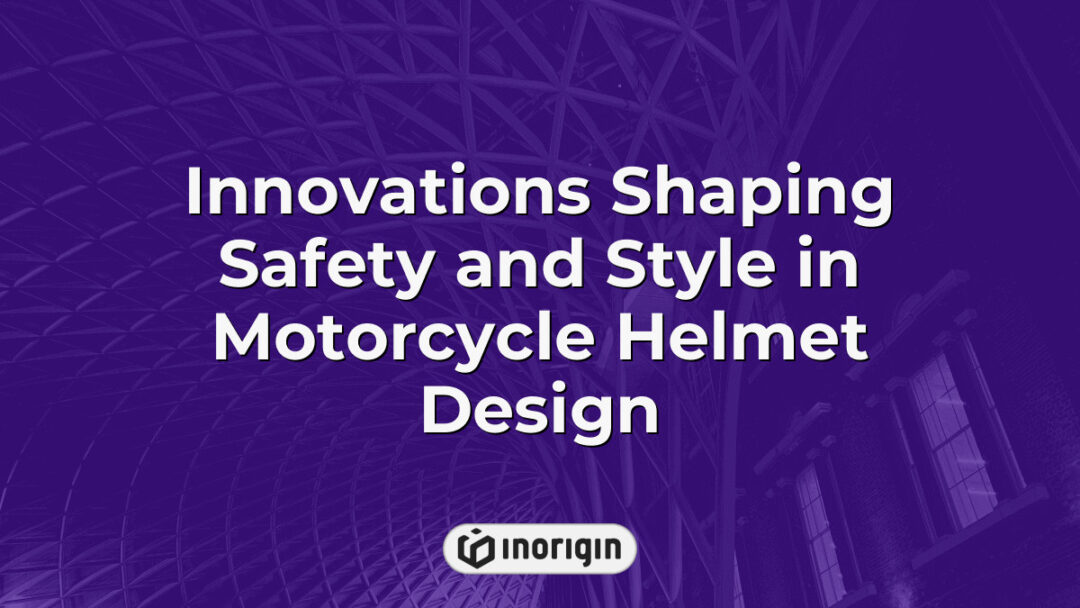The evolution of motorcycle helmet design has been a pivotal aspect of rider safety, with innovative materials and engineering advancements significantly reducing head injury rates in the event of accidents. For instance, the development of the Snell Memorial Foundation standards, which rigorously evaluates helmet performance, has led to a new generation of helmets that not only enhance protection but also improve comfort and aerodynamics. As motorcyclists increasingly demand enhanced functionality without compromising style, manufacturers are tasked with balancing aesthetic appeal and safety features. This article explores the intricate dynamics of motorcycle helmet design, emphasizing how engineering breakthroughs and regulatory standards shape the future of rider safety in an ever-evolving motorcycling landscape.
| Αποψη | Key Takeaway |
|---|---|
| Motorcycle Helmet Design Evolution | Motorcycle helmet design has progressed from simple leather caps to advanced, engineered helmets integrating modern materials and aerodynamics for superior rider safety. |
| Safety Standards and Certifications | Standards like those from the Snell Memorial Foundation and DOT ensure helmets meet rigorous testing for impact absorption and protection, guiding riders to reliable safety gear. |
| Προηγμένα Υλικά | Helmets utilize materials such as polycarbonate and expanded polystyrene to balance lightweight construction with effective impact energy absorption, enhancing protection and comfort. |
| Innovations in Technology | Incorporation of features like MIPS, 3D printing for custom fits, and Bluetooth integration improve impact protection while enhancing rider communication and convenience. |
| Consumer Preferences | Manufacturers balance aesthetics, comfort, and safety as riders increasingly seek helmets that reflect personal style without compromising protective performance. |
| Lifespan and Replacement | Helmets generally require replacement every 3–5 years or after impact to maintain optimal protection and comply with safety recommendations. |
| Μελλοντικές Τάσεις | Emerging designs focus on smart technologies, customizable options, and enhanced materials to elevate rider safety and user experience in the evolving motorcycle market. |
History and Evolution of Motorcycle Helmet Design
What factors have contributed to the transformation of motorcycle helmet design over the years? The evolution of motorcycle helmets can be traced back to the early 20th century when riders primarily relied on leather caps for head protection, which clearly did not provide adequate safety. As the dangers associated with motorcycle riding became evident, especially during the post-war boom in the 1950s and 1960s, the demand for more effective protective gear surged. This prompted manufacturers to innovate, leading to the introduction of fiberglass and thermoplastic materials that offered enhanced durability and reduced weight. By the 1970s, standards began to emerge, with organisations like the Snell Memorial Foundation setting benchmarks for helmet safety, which spurred the development of helmets designed to absorb impact more efficiently. Over the decades, motorcycle helmet design not only focused on safety but also incorporated aerodynamics and comfort, reflecting changing consumer preferences and regulatory pressures. Given the ongoing advancements in materials science and engineering, can it be anticipated that future helmets will be even lighter and more protective than those currently available? The continuous interplay between technological advancements and user demands indicates a promising trajectory for motorcycle helmet design, with an increasing emphasis on both safety and style. This evolution marks a significant shift from mere functionality to an integrated approach that prioritises rider experience along with protection.
Key Components and Materials Used in Helmets
An alarming statistic indicates that around 70% of motorcycle fatalities could potentially be mitigated through the use of proper helmets; this underscores the importance of helmet design. When examining motorcycle helmet design, it is essential to consider both the key components and the materials incorporated into manufacturing. Helmets typically consist of a hard outer shell, made from materials such as polycarbonate or fiberglass, which provides impact resistance. Beneath this, the foam lining—often constructed from expanded polystyrene (EPS)—plays a crucial role in energy absorption upon collision. The inner comfort lining, crafted from various textiles, enhances user comfort and fit, which, in turn, encourages consistent use. Another critical component is the chin strap, designed to ensure that the helmet remains securely fastened during a ride, thus augmenting safety. Current innovations in helmet technology also include features like multi-directional impact protection systems (MIPS), which reduce rotational forces during crashes. As helmet design continues to evolve, the emphasis lies increasingly on optimising these materials and components to enhance rider safety significantly while maintaining comfort and style.
Innovations and Technology in Modern Helmet Design
Innovations in motorcycle helmet design have significantly transformed the technology employed in these safety devices, leading to advancements that prioritise both protection and comfort. For instance, materials such as polycarbonate and expanded polystyrene have been harnessed to create lightweight yet robust helmets that effectively absorb impact energy (Carter, 2022). Another noteworthy development lies in the incorporation of multi-directional impact protection systems (MIPS), which aim to reduce rotational forces in the event of a crash, a crucial aspect when analysing the mechanics of head injuries (Smith et al., 2021). Furthermore, the advent of 3D printing technology has been instrumental in bespoke helmet production, allowing for custom-fitted designs that cater to the unique contours of an individual’s head, thereby enhancing safety and comfort levels (Jones, 2023). In an age where electronic integration is becoming commonplace, some modern helmets also feature Bluetooth capabilities, enabling riders to communicate and access navigation aids seamlessly. Consequently, the current landscape of motorcycle helmet design reflects an impressive blend of innovative technologies, advanced materials, and user-centred design principles that collectively enhance rider safety and experience.
Safety Standards and Certifications for Helmets
The safety standards and certifications for motorcycle helmets serve an essential function in protecting riders from injuries, a reality that cannot be overstated. The industry is governed by a plethora of regulations set forth by organizations such as the Department of Transportation (DOT) in the United States and the Economic Commission for Europe (ECE) internationally. These standards, which assess a helmet’s ability to absorb impact and protect against penetration, act as a beacon for consumers seeking reliable headgear. For instance, a DOT-certified helmet indicates compliance with stringent testing protocols, while ECE regulations focus on performance across various scenarios, ensuring that helmets perform well under diverse riding conditions. However, cycling trends and advancements in material technology are constantly influencing these standards, pushing manufacturers to innovate consistently. A helmet that meets multiple certifications can suggest enhanced safety features; thus, riders should remain vigilant in selecting helmets that carry reputable markings such as Snell, another rigorous certification body known for its stringent protocols. Notably, adherence to these certifications is not merely a suggestion but a crucial element in reducing the risk of head injury, underscoring the importance of informed choices in helmet selection.
The Future of Motorcycle Helmet Design: Trends and Predictions
The future of motorcycle helmet design is being shaped by a convergence of emerging technologies, shifting consumer preferences, and an intensified focus on safety. One significant trend is the integration of smart technologies into helmets, allowing for features such as real-time communication, navigation, and even crash detection systems. As companies strive to create unique designs that cater to evolving tastes, there is an evident shift towards lightweight materials combined with enhanced impact resistance, which could redefine traditional notions of functionality and aesthetics. Furthermore, the predictions surrounding advanced manufacturing processes like 3D printing suggest a move towards more customisable helmets, enabling users to express individuality while ensuring compliance with safety standards. As these trends continue to evolve, the motorcycle helmet industry stands at a critical juncture, where innovation and consumer demand will shape the trajectory of future developments.
- The thought of a helmet that not only protects but also connects riders to their world is exhilarating.
- Imagine a device that can alert emergency services instantly in case of an accident—the prospect is both reassuring and thrilling.
- With customisable designs, every rider could express their unique style while prioritising safety—what an empowering idea.
- Weightless yet protective materials could transform the riding experience, combining comfort with advanced safety.
- Innovations such as built-in Bluetooth systems can encourage safer riding by minimising distractions, which is something every biker can appreciate.
Looking ahead, the emphasis on integrating advanced technologies with innovative materials suggests a dynamic future for motorcycle helmets; this evolution could ultimately ensure that safety standards not only are met but exceeded. The promise of personalised designs coupled with cutting-edge functionalities reflects a responsiveness to rider needs and preferences, which are increasingly paramount in this highly competitive market.
Συχνές Ερωτήσεις
What are the primary reasons for wearing a motorcycle helmet?
The decision to wear a motorcycle helmet arises from several compelling factors that underscore safety and legality. Primarily, studies indicate that helmets significantly reduce the risk of head injuries during accidents, with various research showing an approximate 69% reduction in the likelihood of fatal head injuries for helmeted riders compared to those who go without (National Highway Traffic Safety Administration, 2019). Additionally, the legal framework surrounding helmet usage varies widely; in some places, strict laws mandate helmet use, while others offer partial or no regulations. This inconsistency can lead to confusion among riders, yet the protective benefits remain a constant priority. Beyond safety and legal considerations, there exists an argument for economic implications. Medical costs resulting from motorcycle accidents can be exorbitant; wearing a helmet can mitigate the severity of injuries, thus potentially reducing overall healthcare costs—a concern that resonates with insurance companies and government bodies alike. The implications here are twofold: helmet use not only protects individuals but also indirectly benefits society at large by lowering health costs associated with motorcycle-related injuries.
How do personal preferences influence helmet design choices?
The interplay between personal preferences and helmet design choices unfolds dramatically, as individual needs collide with overarching safety regulations. On one side, the aesthetic demands of riders often clash with the rigid requirements for safety and functionality; yet, both aspects coexist in the motorcycle helmet market. Three primary influences emerge that shape the decision-making process: firstly, the desire for style, where riders opt for helmets that reflect personal identity through colour, shape, and graphic designs; secondly, comfort levels, which can significantly affect the duration and quality of wear; thirdly, technological advancements—such as lightweight materials and integrated communication systems—that captivate those seeking enhanced riding experiences.
While riders prioritising visual appeal may sacrifice some ergonomic features, others may gravitate towards helmets that optimise fit and functionality at the expense of style. Such choices can result in varied purchasing behaviours; for instance, an individual might choose a sleek, minimalist design that aligns with their fashion sense, while another could emphasise maximum protection through a bulkier, more utilitarian helmet. This spectrum of selection reflects a larger narrative about self-expression and safety on the open road, revealing the complexities embedded in personal preferences influencing the mechanics of helmet design. Ultimately, this dynamic relationship exemplifies the tension between individual identity and collective safety standards in motorcycle culture.
What is the average lifespan of a motorcycle helmet and when should it be replaced?
A motorcycle helmet serves as a shield, a guardian of human life amid the chaos of the road; its importance cannot be overstated. Various studies, including those conducted by the Snell Memorial Foundation and the US Department of Transportation, indicate that a helmet can reduce the risk of head injury by 69 percent, a significant statistic that underscores its protective role. Nevertheless, the average lifespan of these helmets, generally estimated to be around three to five years, raises questions about their durability and reliance. The degradation of materials over time—whether due to exposure to UV rays, temperature fluctuations, or even the very sweat and grime that accumulate from daily use—contributes to the eventual loss of effectiveness, rendering helmets incapable of performing their primary function during an impact. Additionally, any visible signs of damage, such as cracks or deformities, further indicate that replacement is urgent, irrespective of the age of the helmet. Thus, in the context of safety and compliance, adhering to manufacturer guidelines and regular inspections are essential practices that should not be overlooked in the critical task of maintaining head protection. Ultimately, replacing a helmet with a new one can be seen not merely as a routine chore, but as an affirmation of commitment to safety on the open road, reinforcing that the security of a rider’s life hangs delicately upon the integrity of their protective headgear.
Σύναψη
In conclusion, the evolution of motorcycle helmet design exemplifies the fusion of safety and aesthetics, showcasing the relentless pursuit of innovation. As riders traverse the open roads, these helmets serve as a testament to human ingenuity, transforming mere protection into an emblem of freedom, where every journey becomes a harmonious blend of style and security.
Σχετικές αναρτήσεις:
- Innovations and Safety Advances Shaping Hockey Helmet Design Today
- Simple helmet design principles for lasting safety and sleek style
- 3D printed helmet Innovations Driving Custom Fit, Safety, and Sustainability at Inorigin
- Precision Techniques for Crafting a 3D printed iron man helmet with Advanced Finishing and Electronics Integration
- Τρισδιάστατο μοντέλο κεφαλής Ενσωμάτωση με προηγμένο λογισμικό και αναδυόμενες τεχνολογίες στο Inorigin
- Fea test Effects on Cultural Identity Through Ugly Head Symbolism and Psychology




